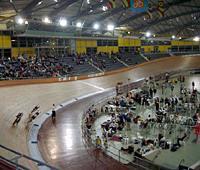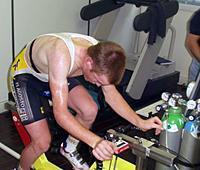
Recently on Cyclingnews.com |
Cyclingnews' Winter Training Series: Part 1
Maintaining fitness, increasing strength and relieving boredom over the winter.
Come wintertime, for the average working-class hero - a.ka. the weekend warrior - motivation is often the biggest hurdle to maintaining one's fitness on the bike. In our first part of Cyclingnews' Winter Training Series, here's some tips from the co-author of Bike Racing 101, former director of the Saturn Cycling Team and former US National Team Coach, RenÚ Wenzel, on how to get you through the chilly season.
Winter Training Part 2
by Robert KŘhnen and Beppo Hilfiker, 2PEAK
Winter Training Part 3
by Eddie Monnier, Ultrafit & Associates
Winter Training Part 4
by Ric Stern, cyclecoach.com
Let it be said immediately: ride outside when you can through the off-season. Nothing beats fresh air and a constant change of scenery to keep the mind alert.
However, if you are forced to train indoors due to weather or other conditions, here are a few ideas to get through those grey months until it is again feasible to venture outside and challenge the elements.
Bear in mind before you go on to read the rest of my humble article that I have focused here on the working class hero and student. I have used principles I use to coach pros, but kept in mind that very, very few in this world have all day, every day to dedicate to be better at going fast on two wheels.
Indoor Velodrome
 |
If you are one of the lucky few to have an indoor velodrome within either riding or driving distance, indoor training can and should be combined with time spent on the velodrome.
Different coaches have different philosophies, but if your coach is a believer in mixing up the off-season training with intensity work in this period, you might even consider racing on the indoor velodrome. It can be a valuable lesson in speed, handling, race positioning and maybe even open the door to new goals. The spinning learned during velodrome racing and training beats any screaming, red-faced spinning instructor trying to make you go nowhere fast in a "sweet-smelling" room.
Spinning, for instance, is so much better learned on your own comfortable (track) bicycle. With a small enough gear so that your heart rate and/or power zone are in the correct windows your coach advises, go ahead and maintain his or her suggested rpm - in my book that would be 90-110 for the entire workout. Keep in mind that you must always balance intensity (in heart rate and/or power), cadence and gearing against one another for whatever your aim is.
If your coach is a believer in a slow aerobic build, the indoor velodrome in the off-season can still be a very useful tool and an excellent alternative to stationary trainer bicycling and outdoor self-masochism. The advantage of consistent riding on the indoor velodrome, besides the obvious lighter clothing vs. winter outdoor clothing or watching irritating CNN announcers say the same thing over and over again, is that almost all physical systems can be trained in a controlled environment - and you are still moving in a forward motion and having to remain alert. After all, you have to turn left now and then if you don't want to inadvertently climb the steepest "hill" you will ever climb - and all in a fixed gear!
Finally, one can also learn to push big gears on the velodrome, but this is best achieved if you have the experience and use of motor pacing. Let the motorcycle wind you up slowly in the BIG gear. Depending on your goals and off-season philosophies, make sure that heart rates and/or power do not exceed your pre-determined zones pushing these big gears. This kind of training can also be an alternative to especially endurance-oriented weight/strength training, which brings me on to next indoor activity when the weather doesn't cooperate with your outdoor training plans.
Weight and/or Strength Training
Off-season weight, strength, and power training have been debated over time probably more than any other form of "cross-training" in cycling. Still, the one thing that's most often overlooked in these debates is the philosophy of "one shoe does not fit all." The following are my philosophies based on my own experience both as a racer and as a coach over the last 35 years.
Weight training is not just a one sided mirror. Below I will try briefly to point out why and how I think weight training can be utilized to achieve many different goals in cycling. Off-season cross training must take into account both mental and physiological factors and weight training for strength is an exercise that can address both.
Weight training for endurance events
Racing in my native Denmark is a hard task. Winters are long, and winter daylight is short; and while Denmark is not the coldest of countries, it is plenty cold when one takes the wind chill factor and usual wet conditions into consideration. It is not unlike my home now in Western Oregon in the US except it is a whole lot warmer here.
In earlier days of racing in Denmark, weight training for cyclists was not that common. An indoor velodrome was not available, trainers were non-existent, and rollers were expensive and not very reliable. Getting outdoors was IT - regardless of the cold and rain. It was only a matter of how long before one would have to get off to walk to bring some warmth back in the feet!
In those years a hero coach of mine created revolution in Denmark when one year his junior athletes came to the season beating up on everybody - even creating furor in the senior elite ranks. The "secret" was utilizing weight training based on multiple sets, high reps and relatively low weights.
These days, weight training is more common and a mostly accepted form of cross/off-season training for cyclists. Weight training is a "comfortable" alternative to going outdoors and in to the cold for the working and student body of the public, while for the elite/pro racer it is a very effective supplement to the weekly riding routine. Feedback is objective, and when working with a group of athletes, it's always easy to tell who's been doing their homework in the weight room and who has not.
Weight training with high reps, high sets and low weights does have a downside. It is very time consuming, and in my opinion, very boring. But this is where weight training also trains commitment and toughness. The endurance racer must be able to dig very deep within himself or herself for long periods of time - a psychological effect lost in so many of the modern, mostly streamlined training programs. They are all physical and very little mental training. This style of weight training program was certainly not created with this in mind, but it became blatantly obvious to me as a coach that it was a very beneficial and telling side effect. Weight training of this kind brings general strength to all the main muscle groups, enhances coordination through core strength, as well as a good portion of confidence and positive morale to the athlete - and it works for the athlete who completes the program!
As the season nears, the newfound strength gains made in the weight room can easily (all is relative) be transferred to the bike and can to a certain degree be maintained with big gear work. Many pros continue their weight training maintenance into the season itself - a practice that non-pros also should copy as long as their schedule allows.
Sprint type events and shorter road racing events
Besides ultimate road racing, everything else in cycling is, to a large extent, sprint-type events, with match sprint, the kilo, keirin and Olympic sprint events requiring some specialized attention.
Sprint type weight training requires a little more emphasis on building bulk and the ability to put out more wattage in a shorter time period, where after muscles are spent and crave recovery. One could claim that the polar opposite of ultimate road racing in cycling is the match sprint event, and it, therefore, also requires the polar opposite kind of weight training. I agree - almost! Polar opposite would be close to nothing and that is definitely not the case. One still has to commit to lots of time in the weight room, but the philosophy is surely different. Where the above program is concentrating 99% on muscle endurance with multiple reps, sets and low loads of weight, sprint-type weight training puts focus on low reps, fewer sets and basically as heavy loads as one can handle and recover from until next session. A sensible diet is also a part of this process, but that is really no different with the endurance athlete.
One of the reasons road racers simply cannot succeed doing a sprint-type weight training program is that it requires too long a recovery time. Muscle fibers are stressed and take time to heal in order to get bigger/stronger. If serious, world class road racers have to recover two to three days after each weight training session, they lose too much mileage build-up and basic cycling training.
A sprint type cyclist does not need the volume of mileage build-up a world class road racer does - at least not at same intensity - and can therefore afford to be more specific in the weight room. His or her rides can be significantly less intense, because what matters is that the muscles get as powerful as possible, and secondly that the muscles retain their memory for cycling movements and endurance.
Indoor cycling
 |
The most common of indoor training is probably utilizing the trainer. For some it's the rollers. A quick tip here: everyone should teach themselves to ride rollers. The rollers are so sensitive to smoothness. They have the advantage of teaching good form and how to minimally steer the bicycle. These secondary positive effects keep the mind on the task at large, namely, riding a bicycle.
I have nothing against trainers, however. During times of forced indoor training I often tell clients to ride the rollers 20 minutes first thing in the morning and then use the trainer for the "serious" ride later the same day.
It IS possible to do almost all kinds of training on the indoor trainer. It's more a matter of "what can you handle?" I once had two coaches that both suffered injuries (broken hand and broken collarbone) at the most unfortunate time right before world championships. They both had time to recover from their injuries, but not time to recover without training and then restart. Both started an "insane" schedule of copying the "outdoor" peak program I had made for them, but on the indoor trainer. Some days they would spend five to seven hours on this "torture" instrument called an indoor trainer. It took immense dedication and they both succeeded in getting selected for the Worlds. Later on, one became a world-class professional, while the other, unfortunately, gave up bicycle racing altogether.
For working heroes and students training through a cold, wet, and/or dark winter, I would say that the 20 minutes every morning upon waking up should be obligatory and then one to two hours on the trainer later in the day a couple of days per week is the way to go. That trainer time can contain your endurance miles, spinning work, big gear work and whatever your coach or mentor helps you put together. Write down your schedule and do not forget to make space for the weight training, and most importantly, recovery time and especially days off!
Below I have made a very simple table for an off-season indoor program:
Winter weeks 1-6
|
Rollers - 20 mins
|
Weight Training
|
Indoor Training
|
Other
|
|
| Monday |
X
|
X
|
||
| Tuesday |
X
|
X (1-2 hours)
|
||
| Wednesday |
X
|
X
|
||
| Thursday |
Day off
|
|||
| Friday |
X
|
X
|
||
| Saturday |
X
|
X (1-3 hours)
|
||
| Sunday |
X
|
X (1-3 hours)
|
Winter weeks 7-12
|
Rollers - 20 mins
|
Weight Training
|
Indoor Training
|
Other
|
|
| Monday |
X
|
X (1-2 hours)
|
||
| Tuesday |
X
|
X
|
||
| Wednesday |
X
|
X (1-2 hours)
|
||
| Thursday |
X
|
X
|
||
| Friday |
Day off
|
|||
| Saturday |
X
|
X (1-3 hours)
|
Day off/Cross-training
|
|
| Sunday |
X
|
X (1-3 hours)
|
Day off/Cross-training
|
Weeks 13: season begins
|
Rollers - 20 mins
|
Weight Training
|
Indoor Training
|
Other
|
|
| Monday |
X
|
X
|
||
| Tuesday |
X
|
X (1-2 hours)
|
||
| Wednesday |
X
|
X (1-2 hours)
|
||
| Thursday |
X
|
X (1-2 hours)
|
||
| Friday |
Day off
|
|||
| Saturday |
X
|
X (1-3 hours)
|
||
| Sunday |
X
|
X (1-3 hours)
|
I will end this article as I started it by saying that in the department of non-specialized training, I recommend staying outside if at all possible. As my most important mentor in cycling always told me, "There is no such thing as bad weather - only wrong clothing!" This holds for the most part true even today - and maybe especially today, where thermal clothing is far and beyond what it was when I was racing. It takes a special kind of person to endure all kinds of weather, but then again, it takes a special kind of person to succeed in our immensely demanding sport.
RenÚ Wenzel and the coaches of Wenzel Coaching can be reached through www.wenzelcoaching.com or 1-541-822-3737.
